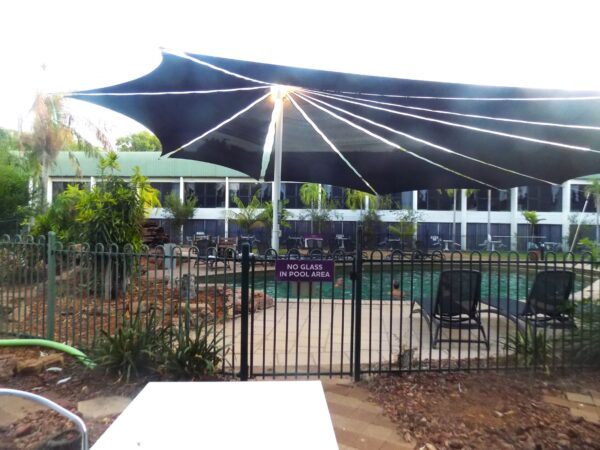
If you’re wondering why I’m starting this post with a picture of the swimming pool outside my room at the Mercure Kakadu Crocodile Hotel. The answer is that it’s the closest picture among the thousands I took that relates to the first of our two nights near Jabiru. We arrived in the early evening, checked into our rooms, and gathered for supper in the (surprise!) hotel dining room.
Sometime after we’d all settled in for the night – I’d guess about 02:15, the alarm sounded with a piercing shriek and a repeated message to evacuate immediately. I had enough wits to grab my glasses and room key but not enough to slip into a pair of shoes before rushing out the door to be greeted by a noisy flock of little corella birds that had massed in the trees.
I don’t know how many evacuation points there were but a few familiar faces gathered at one of them. Although, as this Google maps image shows,
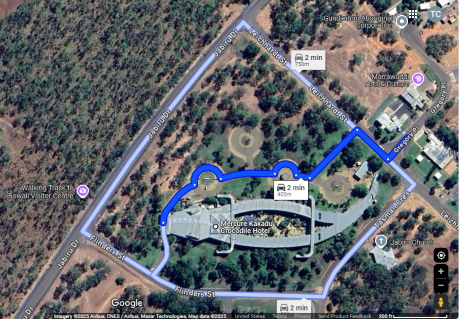
the fire station is less than a kilometer away and literally a two minute drive, there is apparently no one there at night. We had to wait for the crew to assemble, arrive at the hotel, and inspect it before we got the all-clear to return to our rooms half an hour or more later. Apparently, a hotel guest tried to smoke in their room and set off the smoke detector. Shockingly, someone in our group who I won’t name managed to sleep through the entire incident. You can also see from the map image why it’s called the Crocodile Hotel.
On to Kakadu
Almost. Before I write about our first day in Kakadu National Park, I need to get these out of my system:
I wish he alarm had sounded like roosters so I could describe it as a Kaka-d00dledoo moment.
It would have been funny if someone had stepped in feces because I would have said they stepped in Kakadoo-doo.
Okay. I’m Kaka-done. Or am I?
It’s a special place
(Oh place Guwalilna, Warradika, Yumayna.)
I was recently standing in the checkout line at a local grocery store and I began scanning a National Geographic publication called 100 Places That Will Change Your Life. One of the hundred was Kakadu National Park. I didn’t have the chance to read why they’d given it that designation but I can provide a few thoughts of my own.
The first one is simple. It’s the birds. Sure, those corellas we saw are fairly common but, at some time during the year, some 280 species of birds such as these white bellied eagles
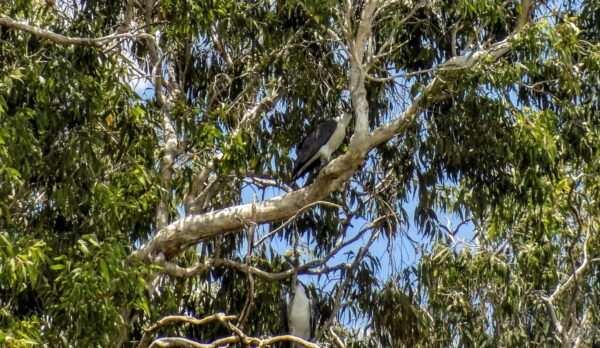
make their home in one of the park’s eight main ecosystems.
Established in three phases beginning 5 April 1979 and more or less ending on 24 June 1991, Kakadu was, at that time Australia’s largest national park. (Although three additional areas were later incorporated into the park, it was surpassed in size in 2021 by the Munga-Thirri-Simpson Desert National Park which at 3,600,000 hectares is a bit less than twice Kakadu’s 1,980,400. It remains the largest park open year round. The desert park closes from December through March because summer temperatures can reach 50 degrees.) For comparison, America’s famous Yellowstone NP which is larger than the states of Rhode Island and Delaware is a mere 898,317 hectares.
Now, if you’re not overwhelmed by the number 280 please consider that this represents a third of all Australia’s bird species. Also keep in mind that as large as the park is, relative to the entirety of the mainland, it’s but a pinpoint as this map from Bing shows.
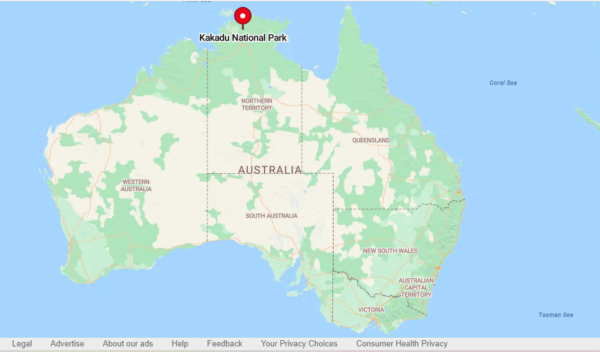
Kakadu’s eight distinct habitats are another factor contributing to making it special. These habitats create remarkable diversity in both its plant and animal life. In addition to the birds, you can find 68 species of mammals (about one-fifth of Australia’s total), 120 reptile species, -at least one of which

is considered quite dangerous – 26 species of frogs, more than 300 tidal and freshwater fish, and 10,000 different species of insects. Of course, these are only the species that have been identified.
As for flora, the most recent data describes more than 2,000 plant species representing about half of all the plant species found in the Northern Territory (or as it’s sometimes colloquially known, the Never Never).
Globally, there are 1,223 UNESCO World Heritage sites and 20 are in Australia. Around the world 40 of these sites have the dual designation of having both cultural and natural significance. Four of these are in Australia and Kakadu National Park is one of them. We’ve seen some of the reasons why the park is considered naturally significant. Culturally, you have at least 60,000 years of continuous human habitation, more than 5,000 rock art sites (we’ll see one tomorrow), and the unbroken connection between the First Nations People and Country.
Yellow Water – Kakadu sun won’t you keep on shining on me
Our first stop of the morning was for a cruise through Ngurrungurrudjba or Yellow Water. This iconic billabong forms part of the South Alligator River floodplain. Its water level fluctuates throughout the year filling with water during Kudjewk and draining into rivers and creeks during Bangkerreng. The water’s surface area generally increases during Kunumeleng – the time of our visit but we didn’t see it as it might normally be because the season had been drier than normal.
It’s biological diversity makes it a crucial habitat for many species of birds and other animals such as the crocodile above or this buffalo.
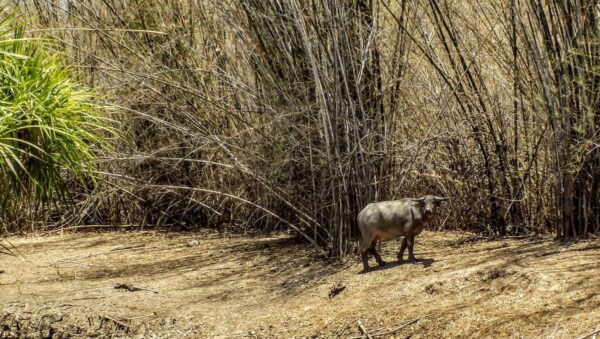
We saw more birds than I can remember or could photograph. Due to their vast biological diversity, these wetlands are recognized under the Ramsar Convention.
The ever changing range of plants and animals at Ngurrungurrudjba has made it a place of great importance to the Bininj / Mungguy people for millennia. In the post the spring of hope, we learned how the people harvest magpie goose eggs and they will even come down from the stone country during Kudjewk to do so. As the billabong shrinks during the dry season of Kurrung the birds crowd into an ever smaller area and become easier to hunt. The plants provide bush tucker and the paperbark trees
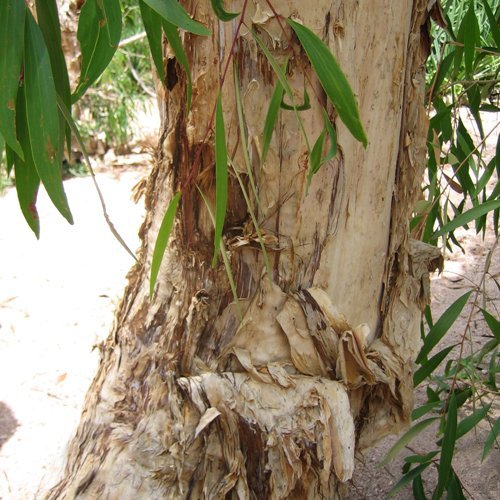
provide bedding, bandages, and shelter.
Although the guide on our boat made every effort to allow us to see as many animals as possible, – an always challenging endeavor in the wild – the unusually dry season made his task all the more difficult.
I should probably remember more about our lunch than I do because we ate at Mimi’s Restaurant and Barra Bar at the Cooinda Lodge. I probably had barramundi.
After lunch we spent an hour or so at the Warradjan Cultural Center where I was permitted this lone photograph showing the seasons.
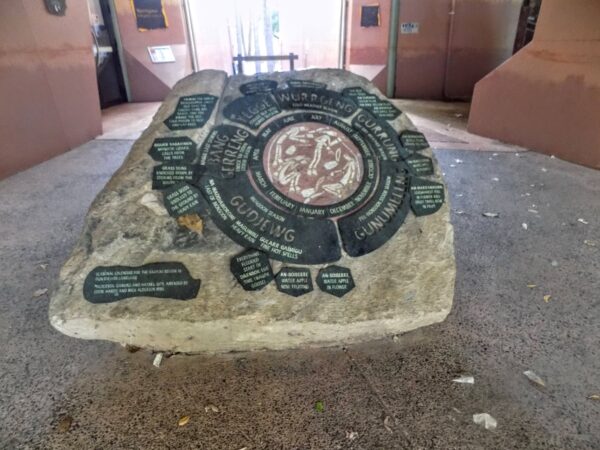
We learned a great deal about kinship within the Bininj / Mungguy People and it’s a subject of such complexity that for me to attempt an explanation would require at least an additional stand alone post. For those interested in learning more, this site, while not specific to the Bininj / Mungguy people, is a good starting point.
Before I move on to a bit of information and controversy about Jabiru – the town adjoining our hotel – I thought you might enjoy listening to a song by the late artist Gurrumul.
Jabiru
We finished one of the most relaxed days of the trip to date with a coach tour of Jabiru – the only town in Kakadu national park and which is somewhat controversial. Jabiru was established at about the same time as the park but it was located at its site to service the Ranger uranium mine. However, it was built on land belonging to the Mirarr clan, raising issues of land rights and cultural preservation. (In an effort to avoid the fate of a place like Cook, it’s currently undergoing an attempt at transforming to serving the tourism industry and appears to be meeting with mixed results.)
The mine closed in 2021 but as is usually the case with uranium mining, it left a changed and contaminated place in its wake and there are ongoing efforts to rehabilitate the area. Leakage of as much as 100,000 liters of waste water per day has polluted the park’s groundwater with heavy metals, toxic chemicals, and radioactive substances likely poisoning food and water sources for the local fauna. Extensive efforts are underway to rehabilitate the area using local seeds to restore the area to a state as close to it’s pre-mined condition as possible. This photo from Australia’s Department of Climate Change, Energy, the Environment and Water shows some of the progress.
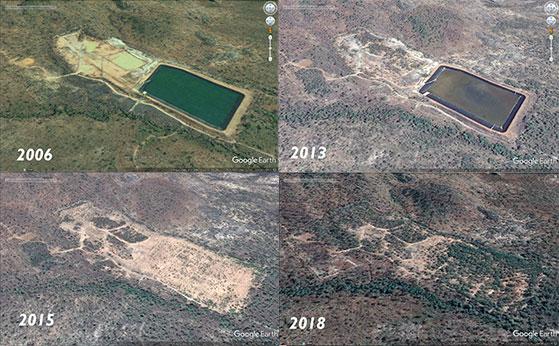
As we made our early return to the hotel, I hoped I’d see a sign listing permissible and impermissible behavior – the Kakadus and Kaka-don’ts for our stay if you will – but I didn’t. (You didn’t really think I was Kaka-done, did you?) In contrast to some other days on the trip, I did, both at the time, and even more in retrospect, wish that the day had been busier.
For now, here are the day’s photos I took that are not included in this post.
In fairness there was absolutely no other place to eat except the hotel!
Absolutely. And that’s sometimes the case. It probably wouldn’t have merited even my brief tongue in cheek comment had there not been so many other hotel meals.
No rolled eyebrow at any of my Kakadu puns? ?
Reference to your first para re the fire alarm . . . No one, not one person in the group even missed the unnamed person who slept through it. No one came to the rescue!!!
Shocking! Were we all so self-centered? I guess so. ?